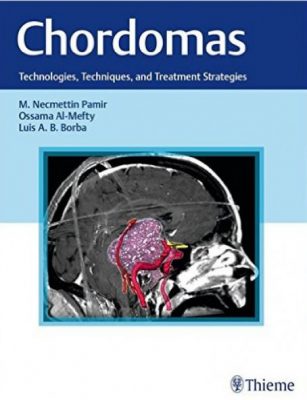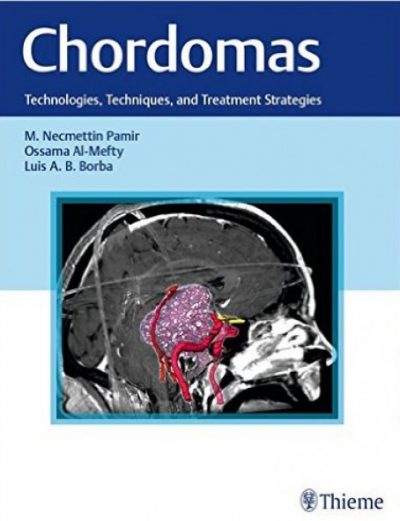 Editors: M. Necmettin Pamir, MD: Ossama Al-Mefty, MD; and Luis A.B. Borba, MD
Editors: M. Necmettin Pamir, MD: Ossama Al-Mefty, MD; and Luis A.B. Borba, MD
Publisher: Thieme
Book Review by: Nano Khilnani
Chordomas are very rare tumors. Because neurosurgeons encounter chordoma cases very infrequently, progress in understanding them cannot be made rapidly.
They occur anywhere along the midline skull base and the spine. They are classified as pathologically benign but clinically malignant. These types of tumors have historically and even up to today, not been very well understood because of their rare occurrence.
Various surgical approaches for clival chordomas have been developed over the last 30 years or so. Recently the endoscopic transphenoidal approach has been widely adopted as a major surgical route, notes Dr. Takeshi Kawase in his Foreword. “Despite such advances in surgical techniques and technology, the re-growth rate and the mortality rate are still high for all occurrences of chordoma because this tumor has a biological nature that is resistant to surgical removal and current radiotherapies.”
This book is the first one to cover chordomas quite comprehensively. Dr. Kawase. writes: “It provides a complete historical perspective and approaches the subject from various scientific and clinical angles.”
This unusual and valuable work essentially summarizes current basic and clinical studies, and also more importantly, indicates contemporary treatment strategies.
Forty-eight specialists in neurosurgery and related fields – ophthalmology, otorhinolaryngology, pathology, radiation oncology, and radiology, from around the United States and five other countries – Brazil, Canada, Japan, Turkey, and the United Kingdom – wrote the 31 chapters of this book that are organized around four Parts named below
- Part I – Definition, History, Demographics, Pathology, and Pathogenesis
- Part II – Diagnosis of Chordomas
- Part III – Surgical Treatment of Chordomas
- Part IV – Special Topics in Chordomas
The extensive range of topics covered in this book includes: anterior approaches to the clivus; charged particle beams in management of clival chordomas; chordomas: a personal perspective; chordomas and chondrosarcomas in the pediatric population; choice of the optimal surgical approach for skull-base chordomas; cranio-orbital-zygomatic approach to chordomas; craniovertebral reconstruction after chordoma resection;
Also: cytogenetics of chordomas; descriptive epidemiology of chordomas; endoscopic approaches for skull-base chordomas’ epidural middle fossa approaches; extended petrosal middle fossa approach; experimental models of chordomas; evolutionary origin of the notochord; experimental models of chordomas; frontobasal approaches to clivial chordomas; and future prospects in the treatment of skull-base chordomas;
And: historical aspects; intraoperative assistive technologies for chordoma surgery; local invasion and metastasis; molecular biology of chordomas; molecular imaging of chordomas; outcome and quality of life of patients with chordomas; pathology of chordomas; radiation treatment for chordomas; radiologic findings and differential diagnosis of chordomas at the skull base; radiologic findings and differential diagnosis in the spine; recurrence in skull-base chordomas and its management; stereotactic radiosurgery for chordomas; surgical decision-making in chordomas; surgery for spinal chordomas; and transcondylar approach to the clivus.
Because chordomas are not only rare but also because their re-growth and mortality rates are high, one of the most important chapters that I would urge students to read is chapter 24 – Chordomas: A Personal Perspective, authored by Ossama Al-Mefty (who wrote Al-Mefty’s Meningiomas which was reviewed here: http://www.bizindia.net/book-review-al-meftys-meningiomas-2nd-edition/) and Rami Almefty.
He notes that the landmark article of Heffelhinger, et al lists only 55 patients with clival chordoma over a 60-year period drawn to their referral center. Meanwhile Al-Mefty states that he has managed over 300 patients in a 30-year period, enabling him to not only have a much more extensive experience managing a large variety of chordomas, but also a more intensive one, managing almost six times as many patients (55 over a 60-year period versus 300 over a 30-year period).
The other reason chapter 24 is important to read is because of not only how impactful his words are, but the headings as well. Here’s a brief outline of Chordomas: A Personal Perspective:
Introduction
- Only Chordoma Is Chordoma
- Chordoma Is Not a Benign Disease
- Tumor Progression in Chordoma
- Once It Recurs, It Never Leaves
- Prerequisite of Successful Treatment
- Pediatric Chordoma
References
Al-Mefty writes from experience that it became clear to him 30 years ago that long-time follow-up is the key to determine patient outcome and the effectiveness of a proposed treatment.
He makes these important observations about chordoma: “Small, incidental, asymptomatic lesions should be radically excised like any other malignancy at the time of their detection.”
In support of this assertion, he presents images which show that “chordoma metastasizes, spreads through the cerebrospinal fluid (CSF) and surgically implants, mandating early treatment to limit the time for metastasis, extradural approaches to avoid CSF spread, and a surgical field precaution to prevent implantation. In other words, it should be handled as a malignant disease.”
This is an important volume on one of the most aggressive and difficult tumors to treat: the cancer-like chordoma. It is also usually located in one of the most difficult-to-access places: the skull base, where critical structures are close by, such as the brain stem, spinal cord, and important arteries and nerves.
Not much was known about a chordoma for about 150 years, when it was first discovered and described. But since then, and especially in the last 30 years or so, much has been learned about these types of tumors and how to precisely to locate and excise them, with advances in diagnostic technologies and surgical techniques.
This book incorporates much of that new knowledge, and it is an important, highly valuable (perhaps critical) resource to own, for neurologists, neurosurgeons, otolaryngologists, radiation oncologists, spine surgeons, as well as for residents and medical students.
Editors:
- Necmettin Pamir, MD is Professor and Chair of the Department of Neurosurgery at Acibadem University School of Medicine in Istanbul, Turkey’
- Osama Al-Mefty, MD, FACS is Director of Skull Base Surgery at Brigham and Women’s Hospital, and Is affiliated with Harvard Medical School in Boston, Massachusetts.
- Luis A.B. Borba, MD, PhD, IFAANS is Professor and Chairman of the Department of Neurosurgery at Federal University of Parana and Evangelic Medical School in Curitiba, Parana, Brazil.







